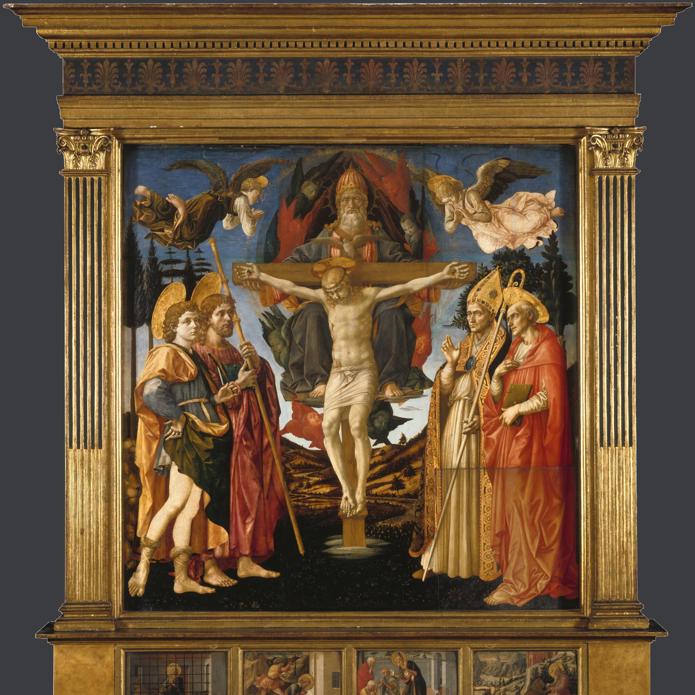Francesco Pesellino and Fra Filippo Lippi and workshop, 'The Trinity', 1455-60
About the work
Overview
This large pala (an altarpiece with a single, unified surface) was painted for a church in Pistoia but was sawn into pieces in the eighteenth century; most of it was later reassembled in the National Gallery. Look closely and you can see lines where the separate fragments were put back together.
It shows the Trinity: God the Father floats in mid-air, holding up the Cross, Christ’s body hanging on it; the dove of the Holy Ghost hovers between them. The altarpiece was commissioned by a confraternity of priests dedicated to the Trinity – hence the subject.
The painting was begun by Francesco Pesellino and completed after his death in 1457 by Fra Filippo Lippi. It was described as ‘half finished’ when Pesellino died and we're not completely sure which bits were done by which artist.
Key facts
Details
- Full title
- The Trinity
- Artist
- Francesco Pesellino and Fra Filippo Lippi and workshop
- Artist dates
- 1422 - 1457; born about 1406; died 1469
- Part of the group
- The Pistoia Santa Trinità Altarpiece
- Date made
- 1455-60
- Medium and support
- egg tempera on wood
- Dimensions
- 185.5 × 91 cm
- Acquisition credit
- Bought, 1863
- Inventory number
- NG727
- Location
- Room 60
- Collection
- Main Collection
- Previous owners
- Frame
- 20th-century Replica Frame
About this record
If you know more about this painting or have spotted an error, please contact us. Please note that exhibition histories are listed from 2009 onwards. Bibliographies may not be complete; more comprehensive information is available in the National Gallery Library.
Images
About the group: The Pistoia Santa Trinità Altarpiece

Overview
This large altarpiece – one of the few in the National Gallery which is almost complete – has had an eventful life. It was commissioned in 1455 from the Florentine painter Francesco Pesellino, and is his only surviving documented work. He died in 1457 and it was finished by Fra Filippo Lippi and his workshop. We know a lot about how and why it was made from the records of the confraternity who commissioned it.
From 1465 it sat on the high altar of the church of the Holy Trinity at Pistoia, but in 1793 the confraternity was suppressed and the altarpiece was taken apart, with the main panel sawn into pieces, and dispersed. Most of it was gradually acquired by the National Gallery and the altarpiece reassembled.
This is the earliest pala (an altarpiece with a single main panel) in the National Gallery.
















